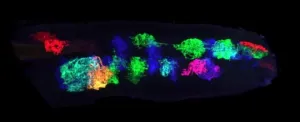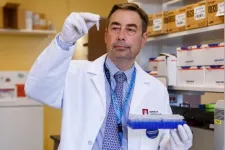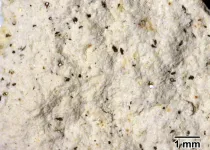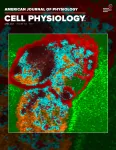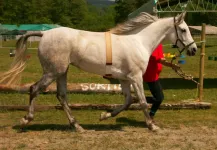INFORMATION:
Carbon dots from human hair boost solar cells
2021-04-08
(Press-News.org) QUT researchers have used carbon dots, created from human hair waste sourced from a Brisbane barbershop, to create a kind of "armour" to improve the performance of cutting-edge solar technology.
In a study published in the Journal of Materials Chemistry A, the researchers led by Professor Hongxia Wang in collaboration with Associate Professor Prashant Sonar of QUT's Centre for Materials Science showed the carbon nanodots could be used to improve the performance of perovskites solar cells.
Perovskites solar cells, a relatively new photovoltaic technology, are seen as the best PV candidate to deliver low-cost, highly efficient solar electricity in coming years. They have proven to be as effective in power conversion efficiency as the current commercially available monocrystalline silicon solar cells, but the hurdles for researchers in this area is to make the technology cheaper and more stable.
Unlike silicon cells, they are created with a compound that is easily manufactured, and as they are flexible they could be used in scenarios such as solar-powered clothing, backpacks that charge your devices on the go and even tents that could serve as standalone power sources.
This is the second major piece of research to come as a result of a human hair derived carbon dots as multifunctional material.
Last year, Associate Professor Prashant Sonar led a research team, including Centre for Materials Science research fellow Amandeep Singh Pannu, that turned hair scraps into carbon nanodots by breaking down the hairs and then burning them at 240 degrees celsius. In that study, the researchers showed the carbon dots could be turned into flexible displays that could be used in future smart devices.
In this new study, Professor Wang's research team, including Dr Ngoc Duy Pham, and Mr Pannu, working with Professor Prashant Sonar's group, used the carbon nanodots on perovskite solar cells out of curiosity. Professor Wang's team had previously found that nanostructured carbon materials could be used to improve a cell's performance.
After adding a solution of carbon dots into the process of making the perovskites, Professor Wang's team found the carbon dots forming a wave-like perovskite layer where the perovskite crystals are surrounded by the carbon dots.
"It creates a kind of protective layer, a kind of armour," Professor Wang said.
"It protects the perovskite material from moisture or other environmental factors, which can cause damage to the materials."
The study found that perovskite solar cells covered with the carbon dots had a higher power conversion efficiency and a greater stability than perovskite cells without the carbon dots.
Professor Wang has been researching advanced solar cells for about 20 years, and working with perovskite cells since they were invented about a decade ago, with the primary objective of developing cost-effective, stable photovoltaics materials and devices, to help solve the energy issue in the world.
"Our final target is to make solar electricity cheaper, easier to access, longer lasting and to make PV devices lightweight because current solar cells are very heavy," Professor Wang said.
"The big challenges in the area of perovskite solar cells are solving stability of the device to be able to operate for 20 years or longer and the development of a manufacturing method that is suitable for large scale production.
"Currently, all the reported high-performance perovskite solar cells have been made in a controlled environment with extremely low level of moisture and oxygen, with a very small cell area which are practically unfeasible for commercialisation.
"To make the technology commercially viable, challenges for fabrication of efficient large area, stable, flexible, perovskite solar panels at low cost needs to be overcome.
"This can only be achieved through a deep understanding of the material properties in large-scale production and under industrially compatible conditions."
Professor Wang is particularly interested in how perovskite cells could be used in the future to power spacecrafts.
The International Space Station is powered by four solar arrays, which can generate up to 120 kW of electricity. But one disadvantage of the current technology of space PVs is the weight of the payload to get them there.
While perovskite would be much lighter, one of the challenges for researchers is to develop perovskite cells able to cope with the extreme radiation and broad range of temperature variation in space - from minus 185 degrees to more than 150 degrees Celsius.
Professor Wang said the solution could be ten years off, but researchers were continuing to gain greater insights in the area.
Currently Professor Wang's research team is collaborating with Professor Dmitri Golberg in the QUT Centre for Materials Science to understand the properties of perovskite materials under extreme environmental conditions such as strong irradiation of an electron beam and drastic temperature change.
"I'm quite optimistic given how much this technology has improved so far," Professor Wang said.
ELSE PRESS RELEASES FROM THIS DATE:
Oregon researchers identify pathway that transitions brain from plasticity to stability
2021-04-08
EUGENE, Ore. -- April 8, 2021 -- Researchers exploring the developing central nervous system of fruit flies have identified nonelectrical cells that transition the brain from highly plastic into a less moldable, mature state.
The cells, known as astrocytes for their star-like shapes, and associated genes eventually could become therapeutic targets, said University of Oregon postdoctoral researcher Sarah Ackerman, who led the research.
"All of the cell types and signaling pathways I looked at are present in humans," Ackerman said. "Two of the genes that I ...
Third of Antarctic ice shelf area at risk of collapse as planet warms
2021-04-08
More than a third of the Antarctic's ice shelf area could be at risk of collapsing into the sea if global temperatures reach 4°C above pre-industrial levels, new research has shown.
The University of Reading led the most detailed ever study forecasting how vulnerable the vast floating platforms of ice surrounding Antarctica will become to dramatic collapse events caused by melting and runoff, as climate change forces temperatures to rise.
It found that 34% of the area of all Antarctic ice shelves - around half a million square kilometres - including 67% of ice shelf area on the Antarctic Peninsula, would be at risk of destabilisation under 4°C of warming. Limiting temperature ...
IU School of Medicine researchers develop blood test for depression, bipolar disorder
2021-04-08
INDIANAPOLIS--Worldwide, 1 in 4 people will suffer from a depressive episode in their lifetime.
While current diagnosis and treatment approaches are largely trial and error, a breakthrough study by Indiana University School of Medicine researchers sheds new light on the biological basis of mood disorders, and offers a promising blood test aimed at a precision medicine approach to treatment.
Led by Alexander B. Niculescu, MD, PhD, Professor of Psychiatry at IU School of Medicine, the study was published today in the high impact journal Molecular Psychiatry . The work builds on previous research conducted by Niculescu and his colleagues into blood biomarkers that track suicidality as well as pain, post-traumatic stress ...
Asteroid crater on Earth provides clues about Martian craters
2021-04-08
The almost 15-million-year-old Nördlinger Ries is an asteroid impact crater filled with lake sediments. Its structure is comparable to the craters currently being explored on Mars. In addition to various other deposits on the rim of the basin, the crater fill is mainly formed by stratified clay deposits. Unexpectedly, a research team led by the University of Göttingen has now discovered a volcanic ash layer in the asteroid crater. In addition, the team was able to show that the ground under the crater is sinking in the long term, which provides important ...
UofL biologists create better method to culture cells for testing drug toxicity
2021-04-08
LOUISVILLE, Ky. - When a new drug is being developed, the first question is, "Does it work?" The second question is, "Does it do harm?" No matter how effective a therapy is, if it harms the patient in the process, it has little value.
Doctoral student Robert Skolik and Associate Professor Michael Menze, Ph.D., in the Department of Biology at the University of Louisville, have found a way to make cell cultures respond more closely to normal cells, allowing drugs to be screened for toxicity earlier in the research timeline.
The vast majority of cells used for biomedical research are derived from cancer tissues stored in biorepositories. They are cheap to maintain, easy to grow and multiply quickly. Specifically, ...
Billboard and storefront ads for cannabis linked to problematic use in teens
2021-04-08
PISCATAWAY, NJ - Adolescents who frequently see billboard or storefront advertisements for recreational cannabis are more likely to use the drug weekly and to have symptoms of a cannabis use disorder, according to a new study in the Journal of Studies on Alcohol and Drugs.
Despite use being illegal for those below age 21 even in states that have approved recreational marijuana, "legalization may alter the ways that youth use cannabis," write the study authors, led by Pamela J. Trangenstein, Ph.D., M.P.H., of the University of North Carolina at Chapel Hill.
An increasing number of states have legalized or are considering legalizing recreational marijuana, and public concern over the risks of cannabis use has declined in recent ...
Gut bacteria "talk" to horse's cells to improve their athletic performance
2021-04-08
A horse's gut microbiome communicates with its host by sending chemical signals to its cells, which has the effect of helping the horse to extend its energy output, finds a new study published in Frontiers in Molecular Biosciences. This exciting discovery paves the way for dietary supplements that could enhance equine athletic performance.
"We are one of the first to demonstrate that certain types of equine gut bacteria produce chemical signals that communicate with the mitochondria in the horse's cells that regulate and generate energy," says Eric Barrey, author of this study and the Integrative Biology and Equine Genetics team leader at the National Research Institute for Agriculture, Food and Environment, France. "We believe that metabolites - small molecules created ...
Structural racism & anti-LGBTQ policies lead to worse health in Black sexual minority men
2021-04-08
Eliminating racist and anti-LGBTQ policies is essential to improving the health of Black gay, bisexual and other sexual minority men, according to a Rutgers-led research team.
The study, published in the American Journal of Preventive Medicine, examined the impact that U.S. state-level structural racism and anti-LGBTQ policies have on the psychological and behavioral health of Black and white sexual minority men.
"Our results illuminate the compounding effects of racist and anti-LGBTQ policies and their implementation for Black gay, bisexual, and queer men. To improve mental and physical health and support their human rights, these oppressive policies must be changed," said lead author Devin English, an assistant professor at Rutgers School of Public Health.
The researchers ...
All-in-one device uses microwave power for defense, medicine
2021-04-08
WEST LAFAYETTE, Ind. - An invention from Purdue University innovators may provide a new option to use directed energy for biomedical and defense applications.
The Purdue invention uses composite based nonlinear transmission lines (NLTLs) for a complete high-power microwave system, eliminating the need for multiple auxiliary systems. The interest in NLTLs has increased in the past few decades because they offer an effective solid-state alternative to conventional vacuum-based, high-power microwave generators that require large and expensive external systems, such as cryogenic electromagnets and high-voltage nanosecond pulse generators.
NLTLs have proven ...
The truth about doublespeak: Is it lying or just being persuasive?
2021-04-08
Doublespeak, or the use of euphemisms to sway opinion, lets leaders avoid the reputational costs of lying while still bringing people around to their way of thinking, a new study has found.
Researchers at the University of Waterloo found that the use of agreeable euphemistic terms biases people's evaluations of actions to be more favourable. For example, replacing a disagreeable term, "torture," with something more innocuous and semantically agreeable, like "enhanced interrogation."
"Like the much-studied phenomenon of 'fake news,' manipulative language can serve as a tool for misleading the public, doing so not with falsehoods but rather with the strategic use of euphemistic language," said Alexander Walker, lead author of the study and a PhD candidate in cognitive ...
